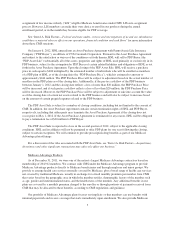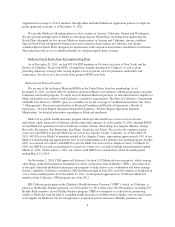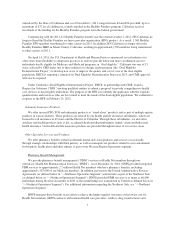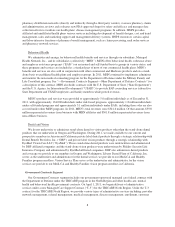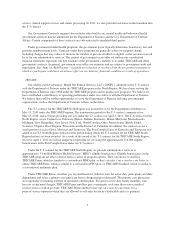Health Net 2011 Annual Report Download - page 17
Download and view the complete annual report
Please find page 17 of the 2011 Health Net annual report below. You can navigate through the pages in the report by either clicking on the pages listed below, or by using the keyword search tool below to find specific information within the annual report.techniques to attract new enrollees and retain existing members, including, without limitation, direct mail, work
day and health fair presentations and telemarketing. Our sales efforts are supported by our marketing division,
which engages in product research and development, multicultural marketing, advertising and communications,
and member education and retention programs.
Premiums for each employer group are generally contracted on a yearly basis and are payable monthly. We
consider numerous factors in setting our monthly premiums, including employer group needs and anticipated
health care utilization rates as forecast by us based on the demographic composition of, and our prior experience
in, our service areas. Premiums are also affected by applicable state and federal law and regulations that may
directly or indirectly affect premium setting. For example, California law limits experience rating of small group
accounts (taking the group’s past health care utilization and costs into consideration) and requires detailed rate
filings for individual and family plans and small employer plans. See “Item 1A. Risk Factors—We face
competitive pressure to contain premium prices.” for additional information on regulations and legislation
impacting our premium setting. Mandated benefits (requiring the coverage of certain benefits as a matter of law,
whether desired by the group or not) also affect premiums. For example, in California and elsewhere, mental
health parity laws have generally broadened mental health benefits under health insurance policies offered by us
and other carriers.
In some of our markets we sell individual policies, which are generally sold through independent brokers
and agents. In some states (including California) and for certain products, carriers are allowed to individually
underwrite these policies (i.e. select applicants to whom coverage will be provided and others who are denied),
except with respect to persons under age 19. In other states, there may be a requirement of guaranteed issue with
respect to certain lines of business that restricts the carrier’s discretion to provide coverage. In guaranteed issue
states, exclusions for preexisting conditions are generally permitted. In California, current law and regulations
allow carriers to individually underwrite policies sold to individuals and families (except as noted above) as well
as large groups, but small group policies may not be underwritten. The completion of customary underwriting
procedures may be a prerequisite to the carrier’s exercise of any cancellation or rescission right with respect to an
issued policy, and the public interest in this practice has caused and may continue to cause additional legislation,
regulation and the development of case law which may further restrict carriers in this regard.
Information Technology
Our business depends significantly on effective and efficient information systems. The information gathered
and processed by our information management systems assists us in, among other things, pricing our services,
monitoring utilization and other cost factors, processing provider claims, billing our customers on a timely basis
and identifying accounts for collection. Our customers and providers also depend upon our information systems
for membership verification, claims status and other information. We have many different information systems
that support our various lines of business and these systems require the commitment of significant resources for
continual maintenance, upgrading and enhancement to meet our operational needs and evolving industry and
regulatory standards. We have partnered with third parties to support our information technology systems and to
help design, build, test, implement and maintain our information management systems, and we are considering
expanding our outsourced information technology arrangements. Our merger, acquisition and divestiture activity
also requires transitions to or from, and the integration of, various information management systems within our
overall enterprise architecture.
In 2011, we continued our multi-year effort to consolidate systems across the enterprise, improve enterprise
data analytics, strengthen our information security posture and consolidate service centers and associated staff. In
addition, we focused on implementing upcoming regulatory and legal compliance requirements in 2011 and will
continue these efforts in 2012. The Department of Health and Human Services has mandated new standards in
the electronic transmission of healthcare transactions, including claims, remittance, eligibility, claims status
requests and related responses, and privacy and security standards, known as HIPAA 5010. Compliance with the
new HIPAA 5010 electronic data transaction standards was required by January 1, 2012, though CMS recently
15


